
..........................................................................................................................................................................................................
a conversation with craig ryan: foresta frames
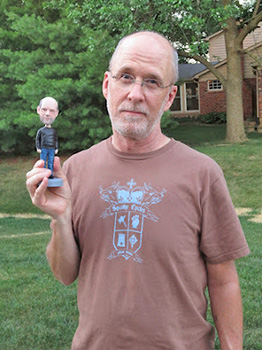
i can but raise my hand in shame as one guilty of misappropriation when it comes to adjectival use of certain words. many of us are guilty of ascribing the word 'art' to items, details and practices that are perhaps less than deserving. it is, of course, an apportioning based on a substantial level of subjectivity; art lies in the eye of the beholder and indeed often in the details, but frequently this is something of an overstatement. riders such as mark cavendish can be thought of as being exemplary practictioners in the art of sprinting, while robert millar maybe personified the grimpeurs' art. but in point of fact, their achievements are possibly more akin to skills or unique facility, highly developed though those may be.
while i'd stop short of describing any of today's carbon frames as representative of any subsection of the artistic panoply, if only because of their repetitive form of assembly, i have heard many (including myself) refer to several hand made steel frames as the epitomy of the framebuilders' art. yet again, this might be more accurately translated as skill or ability, for the construction of said items can conceivably be learned, rather than being the result of an innate ability acquired at birth. of course, there are many so-called artists with exhibits in the world's galleries, who are surely guilty of stretching definition of the word to its ultimate, but again, much of the blame for that rests with marcel duchamp who proposed that his gents urinal placed in a gallery was art because he said it was.
perhaps then, we should leave any decision regarding the validity of such a statement when applied to bicycles to someone whose day job is that of an art teacher. though i have no wish to judge the ability of such keepers of the paintbrush, i'd be far more likely to invest my trust in the judgment of just such a person, and just such a person is american framebuilder craig ryan, based in noblesville, indiana. craig has come late to the party with regard to building frames, at least as far as commercial offerings are concerned, and holds down a day job as an art teacher. was it, therefore, the form of the bicycle that attracted him to the building process, or does it remain an entity of its own?
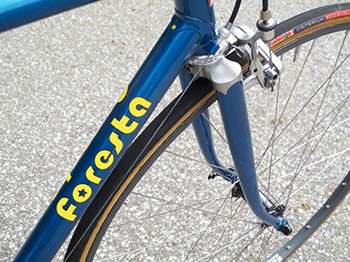
Actually, the bicycle as a form is very limiting for me as an artist. Above all, the bicycle's form is dictated by its purpose, which is to carry a person down the road safely. Any artistic design must remain separate from the geometry and structural components. In order to stay true to that purpose, I have had to look beyond changes in engineering to focus on the whole. I am not trying to reinvent the wheel, the modern double diamond frame has evolved and kept its shape for a reason, it works. It is far more important for the wheels to be in the right place than any stylistic consideration I might dream up. For this reason I keep my artistic urges confined to the unity of design, and elemental flourishes.
"Personal vision and content are of primary importance to expression, and creation. Minor detail flourishes either add, or detract from the whole. My aesthetic is one of simple and refined elements, all contributing to a sense of unity. My lug work is consistent yet simple; while drawing from the rich heritage of the lugged bicycle, it refrains from gaudiness and a forced statement. Unity with a clear sense of identity and purpose are what I am after.
"It's difficult to keep design simple yet effective, but a lugged bicycle provides opportunities. The best way I can describe this is to make an analogy to an artwork hanging on the wall. From a distance the viewer notices the art and is drawn to it because it is visually interesting at a great distance. At a closer distance the details meld with the larger shapes presenting interest. It is clear there is more detail to be seen, and it invites the viewer closer. Upon close examination, viewers are pleased to see small unapparent details emerge. The artwork is successful at all distances.
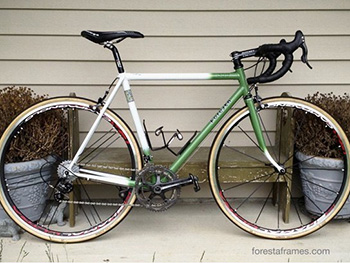 "This is what I strive for in my work, and it's why the bicycle provides such a challenging subject. The aesthetics of the whole, and the notion of hand building something of such elegance speaks to the artist within me. One of the main reasons I don't use a lot of machinery in my building is because I desire the hand built aesthetic. I want to look closely at one of my bicycles and see that it was hand made. As an example, recently on one of the framebuilder internet hangouts there was a long discussion on what machine works best for cutting the slit in the top of the seat tube. Many builders use mills and all kinds of power tools to make this cut perfect. Some commented on how they cut it early on in the process because they were afraid of messing up their nice work. I take pride in knowing my seat lug slot was cut by hand with a hacksaw.
"And if you look carefully at one of my frames you may be able to tell. It's a small part of the whole. My hand cut and drilled lugs often reflect this same thought process. It's part of the whole frame-building package for me. It's not that I am after sloppy work, I want it to be as fine as I can get it, but I want the viewer to be able to see it was made by hand, not some machine."
"This is what I strive for in my work, and it's why the bicycle provides such a challenging subject. The aesthetics of the whole, and the notion of hand building something of such elegance speaks to the artist within me. One of the main reasons I don't use a lot of machinery in my building is because I desire the hand built aesthetic. I want to look closely at one of my bicycles and see that it was hand made. As an example, recently on one of the framebuilder internet hangouts there was a long discussion on what machine works best for cutting the slit in the top of the seat tube. Many builders use mills and all kinds of power tools to make this cut perfect. Some commented on how they cut it early on in the process because they were afraid of messing up their nice work. I take pride in knowing my seat lug slot was cut by hand with a hacksaw.
"And if you look carefully at one of my frames you may be able to tell. It's a small part of the whole. My hand cut and drilled lugs often reflect this same thought process. It's part of the whole frame-building package for me. It's not that I am after sloppy work, I want it to be as fine as I can get it, but I want the viewer to be able to see it was made by hand, not some machine."
I made the move to Islay twenty four years ago to employ myself as an artist, perhaps a high falutin' ideal, but one that, at the time had to be made. though the years prior to this had been fraught with occasional forays into the world of artistic expression, i had myself convinced that any satisfactory development would be forestalled until such time as i was able to occupy the majority of my waking hours with drawing and painting. i was only partially correct. does craig ever find that the day job gets in the way of necessitous brazing, or is he sufficently well organised to avoid such conflicts?
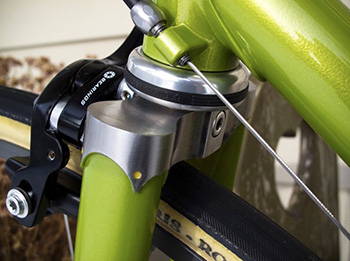
"Yes it does, but (my wife) Susan keeps me on track and off to work I go! Seriously though, I don't have any issues with getting up and starting my days teaching. I've made a career of working with teenagers and I'm proud of it. When I get off from a day at school, I'm ready for some time alone in the shop. I can usually work a couple of hours on any given afternoon, and since Susan works a couple of evenings through the week and most Sundays that gives me the time at the bench I need.
"A bigger problem might be if Susan we to no longer work evenings. I would feel bad taking time away from our limited time together."
though i have yet to meet a frame-builder who finds the act of cycling to be less a part of the process than the hacksaw and brazing torch, it cannot be outwith the bounds of reality for one to have the technical ability to join a bunch of metal tubes, one which is divorced from a love of cycling. many of the chaps who start their careers at chris king's in portland start for the love of a pay packet rather than shiny bike trinkets. is it an obsession with cycling that got him started, or was it aimed more at the bicycle as a desirable object?
"I don't know how you could separate the two, but the bicycle as an object first piqued my interest only after I had been riding for some time. My love for the bicycle has always been strongest while upon it. I'm not sure I could approach building most anything else with as much vigor. The most pleasure I get from a bicycle is riding it."
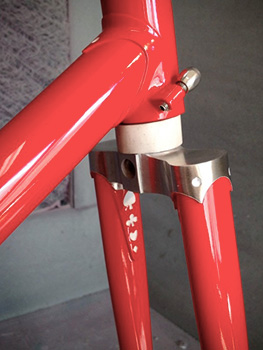
modern web technology has allowed the creation of forums that either support a particular corner of society or, in many a case, confound it. for the individual framebuilder working isolated in a workshop festooned with tubing, lugs, vices and files, there is the velocipede salon, a hangout frequented by craig along with many of his peers. in 2009, he posted there a brief biography of himself and his framebuilding exploits which, at that point, he had pretty much kept to himself. "I've yet to sell a frame. I haven't felt it's time yet. I've been working hard at getting better, and I am very close." was the long delay between starting this second career and offering his first frame for sale a lack of confidence in his skills, or a carefully measured approach to commerce?
"For many years the stars weren't lined up for me to start building. Then one day the opportunity became clear and I started. I'm now in my sixth year of building, and feel my work is the result of a slow incubation of forty years. I've approached this endeavor very methodically and steadily. While making the first 10, 20, or 30 frames the skills one is lacking are not evident and patience is needed. During this period I didn't even think about commerce, I built frames, one after another. When I thought I could stand behind my work I made the commitment, and stopped cutting them up and began to sell them."
fellow framebuilder and admirer, richard sachs, is on record as professing to continually build the same frame over and over again, at each repetition trying yet again to "progress the empire". order a sachs frame, and though i believe it may be possible to own it in a colour other than his trademark red (why would you?), essentially there is no true specific variation from one to the next. does craig mete his skills similarly to only one type of frame or do foresta frames form a myriad of styles?
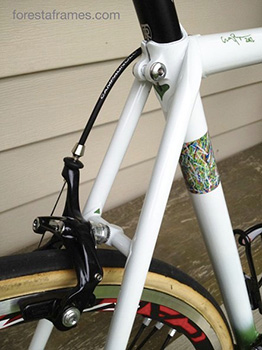
"I specialize in road bicycles designed to take tires up to 28 millimeters with a variety of brake offerings, or fenders. While seemingly limited, my bicycles cover the needs of 98% of the riding a person might do on paved or gravel roads. Very early on I sat down with a veteran framebuilder, and one tip he gave me was to define a style, pick materials, and stick with it. I've taken that advise to heart and it's guided me well as I grow. For materials it's no secret I use Columbus tubes, and Richard Sachs lugs. They are the best and meet my needs well.
"I build frames and forks as matching units, and do not offer a carbon fork. When you buy a Signature '359', there are no extras. Everything is included in the price: frame, fork, paint, matching pump, cable adjusters, seat post bolt, everything. I also offer complete builds based around the Campagnolo Chorus group. I feel this all adds up to a fine bicycle, and limiting choices makes my work manageable."
i have one or two freinds and colleagues who have gone down the road of the custom steel frame, mostly because they want to stamp their own personality upon it, rather than allow that of the builder to shine brightly in their particular pelotons. is craig happy to accede to individual pecadillos, or does he have the final word? "There is always give and take, and I want the end user to be pleased with the results of our work together, but mine is the final word. If it looks like the customer and I have different goals, I help them find another builder. In the end decisions affecting geometry and how the the bicycle performs are important to me. I'll do everything I can to fit the rider, but make it clear the rider has to be "fit" to ride a proper bicycle. I have worked hard to develop what I consider to be my "style," and how the bicycle looks defines me and how my bicycle is perceived in the market. I give the buyer options for lug work, and paint, but every one of my bicycles is clearly a Foresta. I realize I may lose potential customers because of this, but I am confident there are people who will appreciate my bicycles the way I intend."
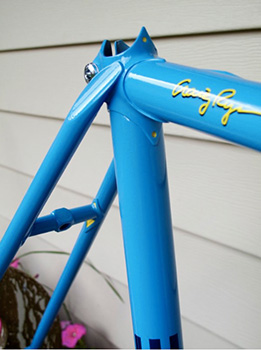
there are two schools of thought when it comes to applying paint or decals to the downtube of any framebuilders offerings. natalie ramsden (sweetpea), and chris king (cielo) both opted to 'de-personalise' the situation, while steven shand, ira ryan, tony pereira and richard sachs have headed in the opposite direction. why did craig choose to place foresta on his frames rather than 'craig ryan'?
"I never seriously considered having Craig Ryan on the down tube. Forest is my middle name, and it's what I put on my first frame. I liked the sound and look of Foresta, so on a whim I started using it. As it turns out I think I made the right decision and do not plan on changing."
one of the confounding factors of being an 'artist' is the amount of time it takes to complete a piece of art. some say you're never truly finished, that it's more a case of deciding when to walk away. even worse, designed to play upon the mind of every artist, is finding that your own exploits take half as long or twice as long as those you admire, immediately reinforcing any notions of inadequacy. frame construction surely inhabits a more regular mode of employ, given its essentially repetitive nature. on average how long does a foresta frame take, start to finish?
"Including paint I have a frame in process about four weeks before it's ready for shipping. That's not actual touch time, but it takes that long to get through all the processes, and I may have other work going on. I spend close to 30 hours working metal, and 15 hours painting. Because I break my building into chunks, I'm never doing any one activity very long. I've come to the point where a frame comes together very quickly, but details take time."
building a steel frame by joining tubes and lugs was once the only satisfactory method of joining all together to form a bicycle. this has since been consolidated, and in some cases superseded, both by fillet brazing and tig welding, the former perhaps more labour intensive, the latter less so. foresta frames are all lugged and brazed. is this because craig sees no merit in the other two?
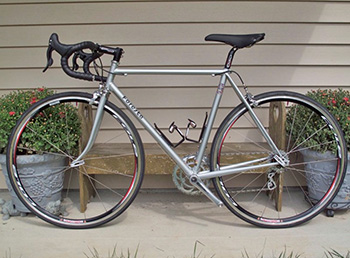
"How the tubes are joined makes little difference to the bicycle going down the road. All methods done correctly are fine with me, but lugs are an important part of my aesthetic. I enjoy seeing others work with welding or fillet brazing, it's fascinating, but not what I wish to do."
when frames moved from steel to aluminium and thence to carbon, in order to match the strength offered by the ferrous metal, many of the tubes required to be oversized. with the perennial quest for stiffness, often in the face of logic, this ever-increasing diameter seems less than keen to stop. such oversizing has had its effect on several of the components used to complete the bicycle, most notably the humble headset. at some point someone realised that increasing the head tube beyond a certain specification would allow the bearing cups to be placed inside the tube before they became like dinner plates on the outside. the more traditional builders have avoided this excess, partly because steel has less need of the increased rigidity. though i may be remiss in my observations, i can see no evidence of internal headsets on foresta frames. is this an expression of luddite tendencies, or that he sees no advantage in the genre?
"I'm sure internal headsets are great in the right application. Bianchi used to do it many years ago with a quill stem. For my bicycles, that 13mm the upper headset stack occupies is important. To lose those 13mm would mean a longer head tube, or stem spacers in its place. I'm not interested in extending my head tube beyond where it is. I don't think this would help the aesthetic of my bicycles. This would impact the visible seat post with a level top tube frame.
"This was a serious question, right?"
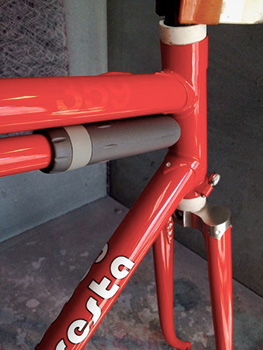
it was.
as i have said before, i am keen to save the world from any unwarranted explosions by refraining from ever indulging in any form of frame building. i can mentally see me now, stepping back to admire my work, brazing torch in hand, as i casually burn through both gas hoses and blow several of us, and the frame, to pieces. i am able bodied, and yet seriously doubt my ability to even attempt building a bicycle from the frame up. craig suffers from rheumatoid athritis which i'm pretty sure cannot make the building process any easier. does he find this a satisfying form of therapy?
"Being diagnosed with RA was a real blow, but it also meant I was able to get help with proper meds and education. Although I have joint damage in both hands I don't feel it limits my ability to build. Early on in the learning curve I had all kinds of trouble, but as I grew more experienced I realized a lot of repetitive work could be avoided with proper skills. Making a lugged frame takes many small skilled steps. Building keeps all of my joints active and strong, which is good for my RA.
"Sometimes I get a bit run down from the long days on my feet, but generally my RA affects my riding more than my building. My hands are the limiting factor with my riding, but life is all about adjusting. In my doctors eyes I am doing fantastic, so I stay positive and count my blessings."
for some, just good enough is good enough. i had thought my wheelbuilding to exhibit some favourable traits until i perceived the work of jude kirstein (sugar) and derek mcclay (wheelsmith). that's when you realise that 'good enough' really isn't good enough. craig ryan has professed the desire to be 'one of the best'. does he feel he's on target to achieve this? "I set my sights high and believe the bicycle I produce is exceptional. There is always room at the top, I don't compromise on methods or materials, and I stand behind my work completely. This view originates deep within my roots, and is as such a goal which guides my work. I attribute it to my background in art and many years of working in a "wet" darkroom."
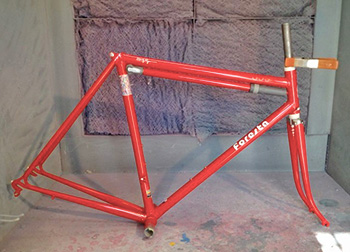
my art teacher at school insisted that all our figure drawing was carried out in ballpoint pen, a technique that horrified my lecturers at art college. however, his motive in employing the humble biro was to stop us from constantly rubbing things out, to concentrate more on the drawing, working into the image rather than removing the evidence of our errant ways. craig ryan has stated that its not often apparent how to get things right until you've done it wrong. does he figure this is just as applicable to art as to framebuilding?
"This has always been my way of thinking, and I tell my students this often. For example, when drawing it is difficult to see the correct line to make until you make a line you know is wrong. I tell my students to draw a line, any line, then redraw the correct line before erasing the wrong one. I know it's kind of vague, but in practice it works, and it can be applied to drawing a perfect circle by hand, or to frame building at any level. This is why I cut up most of the early frames I made. There's no erasing in frame building, just doing it again."
craig is not too many years away from the option of retiring from his day job as an art teacher, meaning a lot more hours with the brazing torch, hacksaw, files and bench-vice. this can do little other than expose him to an expanded horizon, both in available time and the opportunity perhaps to build upon his skillset. does he have an ultimate destination in mind, or is the case for craig ryan that building frames is both the journey and the destination?
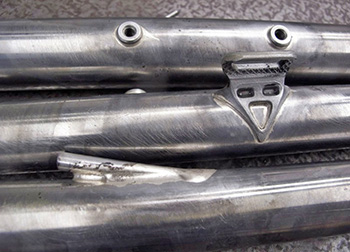
"I don't expect to dominate the world with my frame building, but I think I can set a high standard and elevate my little corner of the world. I build my frames for my own selfish reasons, but having customers makes it a richer experience. I'm not sure where my building will take me in coming years, I will continue to focus on design, quality, and working with one customer at a time. I could retire from teaching at any time, but I enjoy it and will likely continue for some time. In the meantime I intend to build as much as I comfortably can, and when the day comes for me to retire from teaching I will enjoy building full time."
wednesday 13th june 2012
 ..........................................................................................................................................................................................................
..........................................................................................................................................................................................................